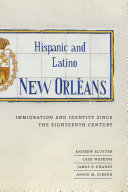

Most ebook files are in PDF format, so you can easily read them using various software such as Foxit Reader or directly on the Google Chrome browser.
Some ebook files are released by publishers in other formats such as .awz, .mobi, .epub, .fb2, etc. You may need to install specific software to read these formats on mobile/PC, such as Calibre.
Please read the tutorial at this link: https://ebookbell.com/faq
We offer FREE conversion to the popular formats you request; however, this may take some time. Therefore, right after payment, please email us, and we will try to provide the service as quickly as possible.
For some exceptional file formats or broken links (if any), please refrain from opening any disputes. Instead, email us first, and we will try to assist within a maximum of 6 hours.
EbookBell Team

4.7
106 reviewsOften overlooked in historic studies of New Orleans, the city’s Hispanic and Latino populations have contributed significantly to its development. Hispanic and Latino New Orleans offers the first scholarly study of these communities in the Crescent City. This trailblazing volume not only explores the evolving role of Hispanics and Latinos in shaping the city’s unique cultural identity but also reveals how their history informs the ongoing national debate about immigration.
As early as the eighteenth century, the Spanish government used incentives of land and money to encourage Spaniards from other regions of the empire—particularly the Canary Islands—to settle in and around New Orleans. Though immigration from Spain declined markedly in the wake of the Louisiana Purchase, the city quickly became the gateway between the United States and the emerging independent republics of Latin America. The burgeoning trade in coffee, sugar, and bananas attracted Cuban and Honduran immigrants to New Orleans, while smaller communities of Hispanics and Latinos from countries such as Mexico, Puerto Rico, and Brazil also made their marks on the landscapes and neighborhoods of the city, particularly in the aftermath of Hurricane Katrina.
Combining accessible historical narrative, interviews, and maps that illustrate changing residential geographies, Hispanic and Latino New Orleans is a landmark study of the political, economic, and cultural networks that produced these diverse communities in one of the country’s most distinctive cities.